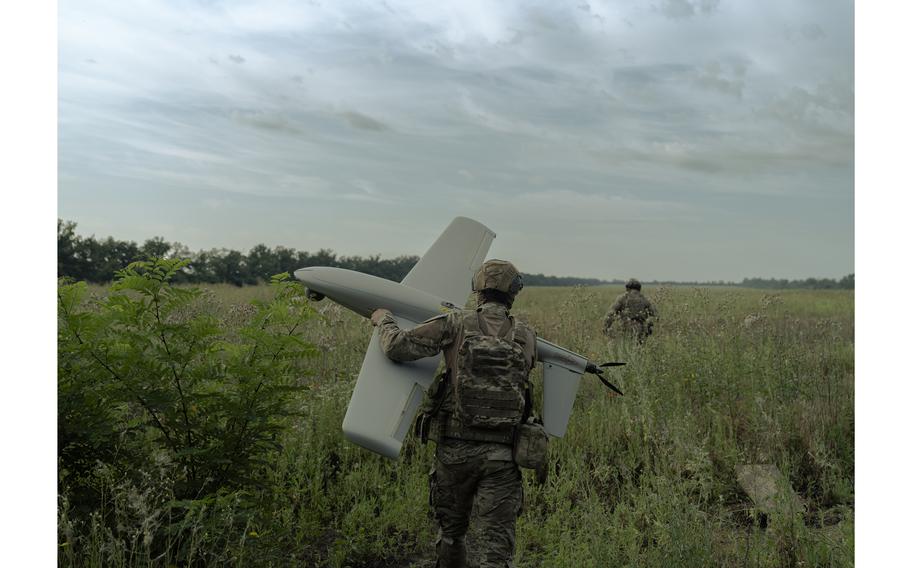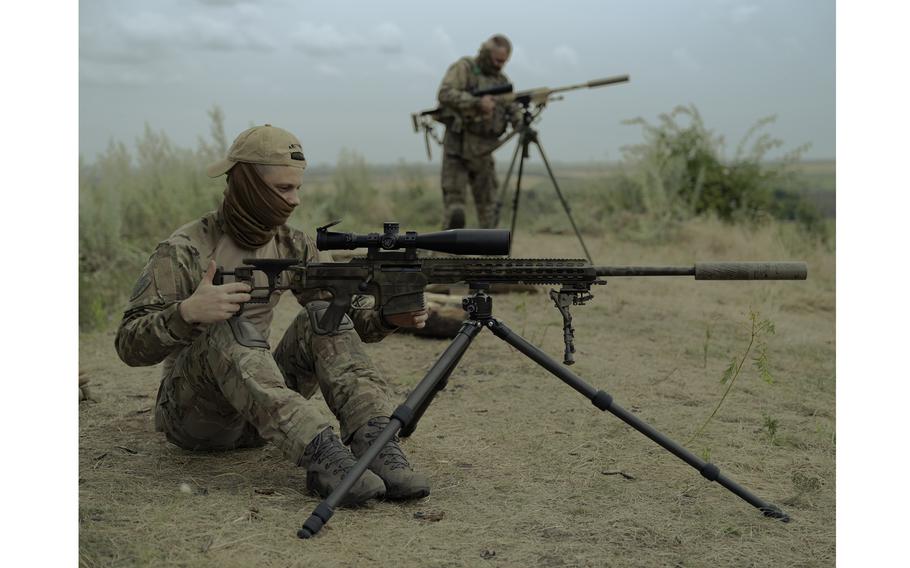Europe
Ukraine's elite forces rely on technology to strike behind enemy lines
The Washington Post August 6, 2023

A self-detonating drone unit of the SBU’s Special Operations Center “Alpha” in the Zaporizhzhia region of Ukraine on June 19, 2023. (Sasha Maslov for The Washington Post)
ZAPORIZHZHIA REGION, Ukraine — Some of Ukraine's most elite special forces are now operating slightly back from the front line — with virtual-reality glasses that give a drone's-eye view.
Last year, there were opportunities to creep into Russian-occupied territory at night to take out enemy targets. Now, with vast minefields and other fortified Russian defenses stalling Ukraine's sweeping counteroffensive, an uncrewed aerial vehicle armed with explosives does that during daylight instead.
A three-man team last month manually directed a drone to hit a cluster of antennas affixed to a tower in Polohy, a town occupied by Russian troops in Ukraine's Zaporizhzhia region. The Russians were using the electronic warfare system to spoil the work of Ukraine's satellite-guided rockets.
The drone, made of Styrofoam-like material and costing $1,500, crashed into one of the antennas, detonating on contact. With the Russians' jamming ability suddenly disrupted, the Ukrainians then destroyed the tower with a strike from a U.S.-provided High Mobility Artillery Rocket System, or HIMARS. The missile slammed into the structure with the sort of precision the Ukrainians have come to rely on in their 17-month fight to expel the Russian occupiers. But had the drone not disabled one of the antennas first, the HIMARS rocket likely would have missed.
That sort of operation has become a trademark of special forces units such as the Security Service of Ukraine's "A," or Alpha, division, which recently granted Washington Post journalists rare access to their teams assisting regular military brigades in Ukraine's counteroffensive, which now stretches across the country's southeast.
.jpg/alternates/LANDSCAPE_910/ukraine-elite-f2b28a70-3481-11ee-a3c0-f4e60791030e%201.jpg)
A self-detonating drone unit. (Sasha Maslov for The Washington Post)
The nature of this war — fought mostly at a distance with artillery and with the sides separated by densely mined fields - has forced traditional special operators to transition from covert tactics they used more often earlier in the conflict. Now, the fighting is largely done with technology, including a wide array of self-detonating drones, while the skilled soldiers direct them from a safe distance — a preferable risk-to-reward ratio than sneaking behind Russian lines.
"What is the problem with going behind enemy lines? Total mining," said Oleh, the first deputy director of the Alpha forces, who, like others in this story, asked to be identified only by his first name for security reasons. "It's almost impossible to go somewhere secretly. You have to use some kind of demining equipment. This means you will already be identified."
The work of the Alpha units offered a window into the early challenges in Ukraine's counteroffensive, where limited advances have been hard-gained as the Russians have hunkered down in defenses prepared over many months. Alpha fighters are trained to do everything from firing an antitank missile to operating a mobile air-defense system. Their snipers are regarded as the best in Ukraine. But all have turned their focus to drones lately as their targets became more difficult to reach.
The struggles of the Alpha fighters illustrate the steep challenges the Ukrainian military now faces at every level — even among its most elite and effective units — as it runs into a Russian force that has prepared and adjusted since its repeated missteps last fall when Ukraine recaptured large swaths of territory in the Kharkiv and Kherson regions.
The eastern front line, near the besieged city of Bakhmut, is less mined than the wide fields of the southern Zaporizhzhia region. But it is still hard to get close to the Russians. Recently, a team of Oleh's fighters had "a relatively shallow entry" into enemy turf near there and 14 of them were wounded, he said.
"And with our resources, the loss of 14 people is a huge loss for us," Oleh said. "Yes, the enemy also suffers losses. But again, are our losses appropriate in these conditions and are they justified? I cannot use these 14 people in other operations in the near future."
"The things that could be done a year and a half ago or a year ago, which were relatively safe and were done, now we need to assess the appropriateness," he added.
Ukraine's main internal security service, the SBU, created its Alpha division in 1994 with a focus on counterterrorism operations. That work remains, but more has been added amid war.
The head of the SBU, Vasyl Maliuk, recently confirmed that its specialists were responsible for attacking the Crimean Bridge last year, a dramatic strike that temporarily disrupted a key Russian supply route. The service has also been behind recent sea drone strikes on Russia's Black Sea Fleet, according to a Ukrainian official, who spoke on the condition of anonymity. The official was not authorized to discuss the matter publicly.
When the Russians were trying to capture Kyiv, Alpha's main task was protecting the government and its leaders, including President Volodymyr Zelenskyy, Oleh said. But since last year, he has spent most of his time in Zaporizhzhia, now overseeing Alpha units assisting in the main focus of Ukraine's counteroffensive — a bid to sever the land corridor between Russia and Crimea.
Alpha is selective: To get in, you have to pass a fitness test, a polygraph and a psychological examination. Efforts to widen recruiting during the war to form a separate assault unit yielded just 80 new members, Oleh said.
Like other special forces, Alpha teams can sometimes have the same functions as regular military brigades, such as operating a howitzer. But their assignments are typically done in small groups — intended to inflict high enemy losses using fewer resources.
The entire Alpha division has just one artillery gun, a 105mm British L119 that's currently in the Zaporizhzhia region, used by a group that calls itself "Tiger Woods," because its strikes are as accurate as the American golfer. At a base near the town of Orikhiv, the fighters have a satellite image of the Zaporizhzhia plains divided into squares. Often the fighting, they said, is taking place in the thin tree lines that separate each field. That's where the Russians have their posts and hide their weapons.
Because of the dense network of mines, the Ukrainians are advancing, slowly, on foot. Here, south of Orikhiv, they have moved more than two miles since the counteroffensive started in early June, the Alpha soldiers said.
Recently, they said, a group of soldiers approached a Russian trench line they thought was abandoned. As they started to walk through it, they realized the trench was booby-trapped with mines. All five Ukrainians were injured by the blasts, and the Russians, who had been hiding nearby, then started shooting, killing four of them. One wounded soldier escaped after other Ukrainian units started firing shells at the trench. They had watched the ambush of their comrades on a feed from a reconnaissance drone.
"Mines are everywhere, on the outskirts of the trenches," said Ilya, an officer in Alpha's artillery unit. "First, it has to be cleared by artillery, then assault groups will go. If the assault group encounters any resistance, it's back to the artillery, then back to the assault groups. Very slowly. But this is our reality."
Rather than contending with minefields, where Alpha has achieved greatest success is with loitering munitions, which range in size and cost. The three-man team that destroyed the antenna tower focuses on targets related to Russians' jamming ability and communication infrastructure.
A second group working in the Zaporizhzhia region recently used a RAM II self-detonating drone made in Ukraine, which looks like a small gray plane with a propeller in the back and can fly up to 25 miles.
The Alpha division alone this year has damaged or destroyed more than 322 tanks and armored vehicles, 48 artillery systems and 65 special equipment objects, including electronic warfare, said Oleh, the deputy director.
But "now it is more difficult," said Pasha, who heads the Alpha unit launching the RAM II drones.
Since last year, the Russians have been using a Pole-21 electronic warfare system that suppresses all satellite navigation over an area of up to 150 square kilometers. That means "we fly by landmarks, we don't have GPS here at all," Pasha said. And often, just when the drone might have a target in sight, the feed will go dark because of the Russians' jamming.

Alpha snipers practicing on a range near the Ukrainian eastern front on June 17, 2023. (Sasha Maslov for The Washington Post)
It's placed a premium on targeting the electronic warfare systems themselves.
"We have very precise means," Pasha said. "The military prioritizes giving us a target to hit, and only then, if we can't hit it, they transfer it to HIMARS or artillery — because artillery may not hit at all, and HIMARS also has nuances. If the electronic warfare is working, it may not hit the target either."
In preparation for the Ukrainians' counteroffensive, the Russians concentrated more of their electronic warfare systems in the Zaporizhzhia region, Pasha said. It's made him yearn for a change of scenery.
"We liked working in the Donetsk region better," Pasha told Oleh. "There are more targets there. There is more active work there, and there is less electronic warfare. ... This area is the most fortified. And they are simply in a dead-end defense."
"Then let's work here for the last day, and then I'll give an order, you'll be transferred there," Oleh told him.
"No problem," Pasha said. "We need results — to destroy the enemy."
An Alpha sniper group near the eastern city Bakhmut said the Russians are dug into their defenses there, too, making it difficult to find targets. The Russians "enter their positions in the morning and do not leave the dugout until night," said Felix, one of Alpha's snipers.
His unit hasn't had traditional sniper work since early May, he said, focusing on reconnaissance in the meantime.
There were more opportunities last year, he said. A year ago, when the western bank of the Kherson region was still occupied, Felix and two others from his sniper unit received intelligence from locals in an occupied village about a Russian military commander. They studied where cows walked through the fields, marking which areas appeared not to be mine. Then at night, the group crossed the Inhulets River by foot, quietly entering enemy-held territory and planting MON-90 mines on the road near his car before retreating, he said.
"He stood out because of his vehicle," Felix said. "Since he was the boss, the car had to be more beautiful and so on."
The group then waited for the right opportunity before remotely detonating the explosives. "After he was neutralized, they had a big panic. They were a bit depressed," Felix said with a laugh.
He lamented that the same kind of mission wouldn't be possible now because the Russians have more intensely mined everything ahead of their outposts. "It's a bit more of a gamble," Felix said.